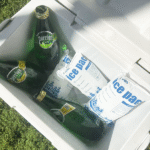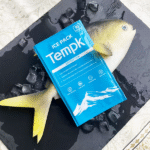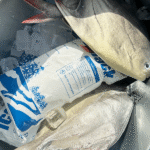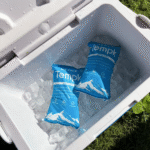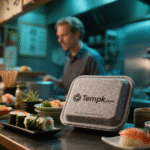Cheap Dry Ice Sheet for Home Use – How Do You Keep Food Frozen on a Budget?
Introducción: When you hear “dry ice sheet,” you might picture an expensive commercial product reserved for laboratories. En realidad, cheap dry ice sheets for home use are available and can keep frozen foods solid for days. Dry ice is simply solid carbon dioxide at –78.5 °C, and when it warms, it turns directly into gas—leaving no watery mess. This article shows you how to select affordable dry ice sheets, pack them safely, and combine them with gel packs for mixed groceries. You’ll learn sizing formulas, home safety rules and 2025 innovations so you can enjoy frozen meals on road trips or during power outages without overspending.
¿Qué es exactamente un cheap dry ice sheet, and why does sublimation make it ideal for frozen foods?
How to choose the right dry ice sheet size, thickness and weight for your cooler, ensuring your food stays frozen without waste.
Simple, step-by-step instructions for handling and layering dry ice sheets safely in a home cooler.
Practical tips for mixing dry ice sheets with gel packs to create separate frozen and chilled zones.
A comparison of dry ice sheets, gel packs and water packs, highlighting cost, duration and residue.
Where to buy affordable dry ice sheets, how to navigate supply shortages and what market trends will shape prices in 2025.
What Is a Cheap Dry Ice Sheet and How Does It Work?
Respuesta directa: A cheap dry ice sheet is a flexible blanket filled with compressed carbon dioxide cells. Each cell contains solid CO₂ that sublimates from solid to gas when warmed above –78.5 °C, absorbing heat and maintaining extremely cold temperatures without melting. Unlike gel or water ice, dry ice leaves no liquid, preventing soggy messes and freezer burn. Because CO₂ gas sinks, it blankets your frozen food, keeping it solid for up to three days.
Explicación expandida: Dry ice sheets behave like a layer of deep-freeze power. When you place one over frozen goods in an insulated cooler, the perforated sheet releases cold vapour that sinks to the bottom, enveloping the contents. The plastic film separates the CO₂ cells from your food, making the sheet safer than loose pellets or blocks. Each kilogram of dry ice absorbs approximately 571 kJ of heat as it sublimates, which is why a small sheet can keep ice cream rock-solid during a three-day road trip. Cheap dry ice sheets are single-use because the CO₂ eventually escapes; sin embargo, they are often more cost-effective than purchasing dry ice pellets for home use. Their flexible design lets you wrap them around irregular items, eliminating hot spots and wasted space.
Key Properties of Dry Ice Sheets
| Propiedad | Descripción | Practical Meaning for You |
| Rango de temperatura | Maintains –78.5 °C to –20 °C, much colder than household freezers | Keeps ice cream, seafood and meat solid; too cold for salads or produce |
| Duración | Holds cold for 6–72 hours depending on sheet thickness and load | Supports day trips or multi-day deliveries without refreezing |
| Residuo | Sublimates directly to gas; leaves no water | No messy meltwater; your cooler stays dry |
| Reutilizabilidad | De un solo uso; CO₂ dissipates during sublimation | Plan enough sheets; cannot be refrozen |
| Best uses | Alimentos congelados, helado, productos farmaceuticos | Ideal para kits de comida, cámping, emergency cold storage |
User tip: Because dry ice sheets are very cold, you should never place them directly on delicate foods like bread or fresh vegetables. Always interleave a piece of cardboard or a towel to buffer the cold and avoid freezer burn.
Choosing the Right Cheap Dry Ice Sheet for Your Home
Respuesta directa: To choose the right dry ice sheet, match the weight of dry ice to the weight of your frozen goods for up to 24 horas. Para duraciones más largas, use 1–1.5 kg of dry ice per kilogram of food for 24–48 hours and up to 2 kg for 48–72 hours. Select thicker sheets (24 mm) for longer trips and thinner sheets (12 mm) for day outings.
Explicación: Sizing your dry ice sheet is crucial because under packing may cause thawing, while over packing wastes CO₂ and money. A simple rule of thumb is 1:1 weight ratio for 24 hour trips. For a two-day road trip carrying 4 kg of frozen food, you would need around 4–6 kg of dry ice sheet. For three-day cross-country drives or emergency freezer backups, double the weight of dry ice to 8 kg. Each sheet is labelled with its mass per square metre; multiply the sheet’s area by the mass to calculate total CO₂ weight. Scored mini-sheets allow you to adjust the quantity easily without having to cut or break the slab.
Types of Cheap Dry Ice Products and Home Selection Criteria
| Tipo | Tasa de sublimación & Tener tiempo | Beneficio práctico | Suggested Home Use |
| Slabs/Bricks (2–10 lb) | Sublimación más lenta; endurance for 24–72 h | Stable cold for long routes; manejo mínimo | Ideal for freezer backup during power outages or long road trips |
| Pellet Bags | Fast pull down; sublima rápidamente | Enfriamiento rápido; use for pre-chilling or quick freezing | Useful for quickly refreezing partially thawed foods before adding sheets |
| Scored Sheets/Mini Slabs | Flexible placement around irregular loads | Wrap around food; support mixed payloads | Great for meal kits, lunch deliveries, and irregular containers |
Choosing factors:
Shipment size and cooler dimensions: Use slabs for large coolers and scored sheets for small lunch bags or irregularly shaped packages.
Trip duration and ambient temperature: Longer journeys or hot climates require thicker sheets or additional pellets. Begin with 5–10 lb of dry ice for every 24 hours and adjust based on insulation and weather.
Flexibility needs: Para uso en el hogar, mini-sheets let you tear off sections to fit odd shapes without waste. Bricks and pellets may be cheaper by weight but are less adaptable.
Practical Tips for Budget-Conscious Packing
Pre freeze your goods: Freeze your food for at least 24 hours before packing to ensure everything starts at the desired temperature. This reduces the amount of dry ice needed.
Position dry ice on top: Place the sheet above your frozen items so cold air sinks and blankets them.
Run a lane test: If you’re planning a long trip, conduct a trial run with a temperature logger. Monitor the internal temperature and weight loss of dry ice, then refine your packing method.
Layer for efficiency: For irregular loads, use multiple mini sheets rather than one big slab. This ensures even cold distribution and prevents hot spots.
Caso real: A seafood company reduced thaw losses from 7 % to 1.5 % by switching to bulk dry ice packs and adding vented lids and liners to their containers. The same principle applies at home: combining cheap dry ice sheets with insulated liners can significantly reduce food waste during long trips.
Safe Handling and Storage Practices for Dry Ice Sheets
Respuesta directa: Dry ice sheets are safe when handled correctly, but they can cause frostbite, asphyxiation or explosions if misused. Utilice siempre guantes y gafas aislantes., handle the sheets with tongs, store them in a well-ventilated area and use vented containers—never airtight ones.
Explicación expandida: Dry ice sits at –78.5 °C, cold enough to freeze skin cells within seconds. Each pound of dry ice releases about 250 litres of CO₂ gas, que puede desplazar el oxígeno en espacios cerrados, leading to difficulty breathing. Dry ice also creates pressure inside sealed containers; never store it in a screw-top cooler or glass bottle because expanding gas can cause an explosion. Al transportar hielo seco, use vented lids or loose-fitting lids to allow gas to escape. For shipments, label packages with “Carbon Dioxide, Sólido (Hielo seco), UN1845” and include the net weight and hazard markings.
Safety Hazards and Preventive Measures
| Peligro | Ejemplo | Riesgo | Safe Practice |
| Congelación (contacto) | Touching dry ice directly | Severe cold burns | Use guantes aislados; use tongs |
| Asphyxiation | CO₂ gas displaces oxygen in confined spaces | Difficulty breathing or unconsciousness | Work outdoors or in ventilated areas |
| Explosión | Sealed containers can burst under pressure | Injury from flying debris | Use vented coolers; never seal dry ice in screw-top containers |
Storage and Disposal Guidelines
Store in ventilated coolers: Keep dry ice sheets in an insulated cooler or styrofoam box that allows gas to escape.
Avoid airtight refrigerators: Do not place dry ice in your home refrigerator or freezer; the CO₂ gas can build up and damage the appliance.
Deshacerse de manera responsable: Let unused dry ice sublimate in a well-ventilated outdoor area away from people and pets.
Keep out of reach of children and pets: Educate family members about the hazards of dry ice.
Combining Dry Ice Sheets with Gel Packs: Creating Frozen and Chilled Zones
Respuesta directa: Mixing dry ice sheets with gel packs allows you to maintain both frozen and chilled sections inside a single cooler. Place dry ice sheets near items that must remain frozen and gel packs near items that should stay at refrigerator temperatures. Separate the two with cardboard or a barrier.
Explicación: Many home scenarios involve transporting both frozen and perishable goods—for example, frozen steaks and fresh salad. Dry ice sheets keep frozen items at –20 °C or below, while gel packs maintain a milder 2–8 °C range. When the two are combined, the gel packs absorb some of the sublimation heat from the dry ice, slowing its consumption and extending overall cooling duration. This layered strategy creates microclimates within your cooler, ensuring delicate items are not accidentally frozen while keeping freezer items solid.
Practical Tips for Hybrid Packing
Separate zones: Use cardboard or foam partitions to create sections. Place gel packs around produce, dairy or beverages and dry ice sheets above the frozen meat section.
Stagger thickness: Use thicker sheets or multiple sheets on the frozen side and thinner gel packs on the refrigerated side. This prevents overcooling sensitive foods.
Temperatura de monitor: Use a digital thermometer or temperature strips to ensure each zone stays within its safe range. Inexpensive data loggers can record temperature curves for review.
Estudio de caso: A meal delivery company replaced bulky gel bricks with gel sheet dry ice packs. The new packs kept meals at –20 °C for 24 horas, reduced packaging weight and improved customer satisfaction. For your home, switching to thinner gel sheets for the chilled zone can save space and money while maintaining quality.
Cheap Dry Ice Sheets vs Gel and Water Packs
Respuesta directa: Cheap dry ice sheets provide the coldest temperatures (–78,5°C) and no moisture, making them essential for frozen foods. Gel packs maintain 0–4 °C and are reusable, ideal for chilled items. Water packs are cheap but melt quickly and leave a lot of water.
Comparative overview:
| Característica | Capa de hielo seco | Paquete de gel | Paquete de agua |
| Rango de temperatura | –78.5 °C to –20 °C | 0 °C to 4 °C | 0 °C to 15 °C |
| Duración del enfriamiento | 6–72 h depending on thickness | 24–48h (extended with insulation) | 4–6 h for lunch boxes |
| Residuo | Ninguno; sublimate al gas | Slight moisture when gel thaws | Significant water as ice melts |
| Reutilizabilidad | No; un solo uso | Sí; can be refrozen 100+ veces | Sí; but prone to leaks |
| Typical uses | Alimentos congelados, productos farmaceuticos | Kits de comida, comestibles, vacunas | Picnics, lonchera |
| Costo & sostenibilidad | Mayor costo; CO₂ shortages may occur | Costo moderado; reusable reduces waste | Bajo costo; but short life increases waste |
When to choose each:
Capas de hielo seco: Use them when you must keep items frozen for longer than 24 horas, avoid any moisture and have proper safety measures. Ideal for camping trips, shipping frozen cakes or storing vaccines in an emergency.
paquetes de gel: Use them for chilled goods like dairy, producir, chocolate and cosmetics because they keep foods at refrigerator temperatures without freezing. They are cheaper and reusable for home meal deliveries.
paquetes de agua: Use them for short events like picnics or lunch boxes where cost is paramount but you don’t mind condensation.
Where to Buy Cheap Dry Ice Sheets and Cost Considerations
Respuesta directa: Purchase cheap dry ice sheets from specialized cold chain suppliers, local industrial gas distributors or packaging companies like Tempk. Mainstream retailers may not carry them because dry ice is classified as a hazardous material. Always verify that sheets meet your weight requirements, include venting and use quality plastic films.
Explicación expandida: The dry ice market has experienced volatility in recent years due to CO₂ supply constraints and rising demand. Consumption has grown about 5 % per year, while CO₂ production has increased only 0.5 % annually, causing occasional shortages and price surges of up to 300 %. A pesar de esto, the global dry ice market is projected to grow from USD 1.54 billion in 2024 to USD 2.73 billion by 2032 (a 7.4 % CAGR). To navigate potential shortages, manufacturers are building local production hubs and exploring on-site CO₂ capture and reuse. When sourcing cheap dry ice sheets, ask suppliers about their CO₂ source and whether they utilise bio ethanol captured CO₂, which offers a lower carbon footprint.
Balancing Cost and Performance
Size your dry ice correctly: Use the formula Dry ice (lb) ≈ (Hold time in hours ÷ 24) × (5–10) × Lane factor, where the lane factor ranges from 1.0 for cool conditions to 1.3 for hot routes. Por ejemplo, a 48 hour trip in moderate climate (lane factor 1.1) requerimiento (48/24) × 7.5 × 1.1 ≈ 16.5 lb of dry ice. Choose thicker sheets if you need to reduce total sheet count but remember that thicker sheets cost more.
Actualizar aislamiento: Investing in better insulation reduces dry ice consumption. Field tests show that switching from EPS (basic styrofoam) to EPP (polipropileno expandido) o VIP (paneles de aislamiento al vacío) cuts dry ice requirements by 10–25 %.
Use hybrid solutions: Combining dry ice with gel packs or PCMs reduces the amount of dry ice needed, lowering costs and easing regulatory burdens.
Order in bulk: Many suppliers offer lower per-pound rates for bulk purchases. Establishing long-term contracts can secure priority access during high-demand periods and lock in pricing.
Ask about sustainability: Choose suppliers who invest in CO₂ capture from bio-ethanol plants or industrial exhausts, which reduces the environmental footprint of your cooling solution.
Affordability vs Sustainability: 2025 Perspectiva del mercado
Balancing low cost with sustainability is a growing concern. Dry ice remains indispensable for ultra-cold shipments, yet alternatives such as PCMs and gel packs are gaining traction for chilled products. High R insulation, improved packaging and hybrid solutions reduce dry ice consumption by 10–25 %, saving money and lowering CO₂ emissions. Customers are increasingly asking suppliers to disclose CO₂ sources and adopt bio based capture methods. Regional plants and local production improve availability and cut transport distances, which may stabilise prices.
2025 Innovations and Trends in Home Cold Chain Solutions
Descripción general de la tendencia: The cold chain industry is evolving quickly due to sustainability pressures, technological advances and changing consumer expectations. En 2025, new materials, smart sensors and AI route optimisation make dry ice sheet use more efficient and affordable. This section summarises the latest developments that matter for home users.
Latest Advances at a Glance
Green logistics and CO₂ recovery: Dry ice production relies on industrial CO₂. To reduce environmental impact, manufacturers are capturing CO₂ from bio ethanol plants and industrial exhausts. Choosing suppliers who use reclaimed CO₂ helps reduce your carbon footprint.
AI and IoT monitoring: Artificial intelligence and Internet of Things sensors now optimise cold chain routes and monitor temperature, humedad y ubicación en tiempo real. Even home users can purchase inexpensive data loggers that send temperature alerts to their phones, prevenir el deterioro.
Ligero, smart shipping containers: Advances in container design include lightweight insulated boxes with built in sensors and solar powered refrigeration units. Paneles de aislamiento de vacío (VIP) and aerogel materials provide high R values, reducing the amount of dry ice needed and making your cooler easier to carry.
Sustainable packaging materials: Gel and hybrid packs that are reusable and leak-free reduce waste compared with single-use dry ice sheets. Recyclable outer films and curbside-friendly liners make disposal more eco-friendly.
Market growth and resilience: The global cold chain market is expected to reach US $372.0 billion by 2029. This growth drives innovation but also emphasises resilience: regional production plants, renewable energy-powered refrigeration and climate-adapted infrastructure are necessary to face supply fluctuations and extreme weather.
Hybrid solutions: Combining PCMs, gel packs and improved insulation is a major trend. Hybrid packs deliver various temperature zones in one container, reducing total dry ice usage and regulatory complexity. Para uso en el hogar, pre-packaged kits with both dry ice and PCM inserts allow you to keep frozen foods and salads at their ideal temperatures.
Preguntas frecuentes
Pregunta 1: How long does a cheap dry ice sheet last in a typical cooler?
A standard dry ice sheet lasts between 6 y 72 horas, depending on thickness, insulation and ambient temperature. Thin 12 mm sheets hold cold for about a day, while thick 24 mm sheets can maintain deep-freeze temperatures for up to three days. Always pre-chill your cooler and food to maximize performance.
Pregunta 2: Are dry ice sheets safe for food storage at home?
Sí, dry ice sheets are safe if handled properly. Always wear insulated gloves or use tongs to avoid frostbite, and ensure the cooler is vented to release CO₂ gas. The sheets’ plastic film prevents direct contact with food, so your products remain clean and dry.
Pregunta 3: Is it cheaper to use dry ice sheets or gel packs for home shipments?
Dry ice sheets are more expensive per sheet but provide longer hold times and eliminate mess. Gel packs are cheaper upfront and reusable, making them cost-effective for short trips or chilled goods. If you often ship or travel with frozen items, dry ice sheets can save you money by preventing product loss and reducing the number of shipments.
Pregunta 4: Can I use dry ice sheets in a styrofoam cooler for a road trip?
Sí. Espuma de poliestireno (EPS) coolers are common for dry ice. Sin embargo, they offer lower insulation than EPP or VIP panels, so you may need more dry ice sheets. Upgrade to an EPP cooler if you travel in hot climates or need longer hold times.
Pregunta 5: How do I store unused dry ice sheets?
Keep unused dry ice sheets in a ventilated cooler at room temperature or slightly below. Do not seal them in an airtight container. Use them within a couple of days, as sublimation continues even in storage.
Pregunta 6: Can I rehydrate or reuse dry ice sheets?
No. Once the CO₂ has sublimated, the sheet no longer provides cooling. Some gel sheet dry ice packs combine CO₂ pellets with a gel layer; these can be hydrated and frozen again until the textile surface becomes unhygienic.
Resumen y recomendaciones
Puntos clave: Cheap dry ice sheets are flexible blankets filled with solid CO₂ that maintain ultra-low temperatures between –78.5 °C and –20 °C without leaving water. They keep frozen foods solid for 6–72 hours, making them ideal for road trips, camping or emergency freezer backups. Choose the right sheet size by matching dry ice weight to food weight (1:1 para 24 horas, 1–1,5:1 for 24–48 hours and 2:1 for 48–72 hours). Always handle with insulated gloves, ventilate containers and label packages. Combine dry ice sheets with gel packs to create frozen and chilled zones and reduce total CO₂ usage. Consider cost and sustainability: upgrading insulation and buying in bulk can cut dry ice consumption by up to 25 %, while hybrid solutions provide flexibility and eco-friendly benefits.
Consejo procesable:
Plan your load: Before your trip, list the frozen items and their weights. Buy dry ice sheets that match the total weight and choose thickness based on trip duration.
Prepare your cooler: Pre-chill your cooler and goods, and position the dry ice sheet on top of the frozen items to maximise cold coverage.
Use partitions: For mixed groceries, separate frozen and chilled zones using cardboard and gel packs.
Follow safety rules: Use guantes y gafas, ventilate containers, label packages and keep dry ice away from children.
Optimise cost: Actualizar aislamiento, use hybrid packs and order dry ice sheets in bulk to reduce per-trip expenses.
Mantente informado: Monitor 2025 trends like AI-driven route optimisation, IoT sensors and sustainable CO₂ capture methods to future-proof your cold chain solutions.
Acerca de Tempk
Tempk is a leading innovator in cold chain solutions, offering a wide range of ice packs, capas de hielo seco, PCM bricks and insulated containers. We design cost-effective products for both industry and home users, ensuring reliable temperature control while reducing waste. Nuestra R&D centre focuses on eco-friendly materials and smart monitoring to deliver safe and sustainable refrigeration. Nosotros provide personalised guidance to help you choose the right cooling solution for your needs.
Llamado a la acción: If you’re ready to upgrade your cooler with affordable dry ice sheets or want expert advice on mixing dry ice with gel packs, contact Tempk’s cold chain specialists hoy. We’ll help you select the ideal products for your next adventure or shipment.

















